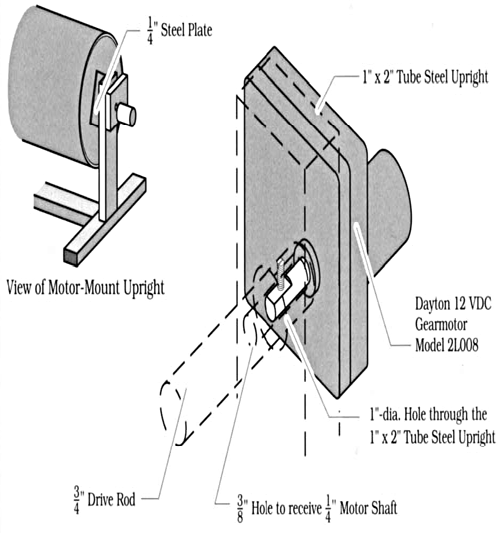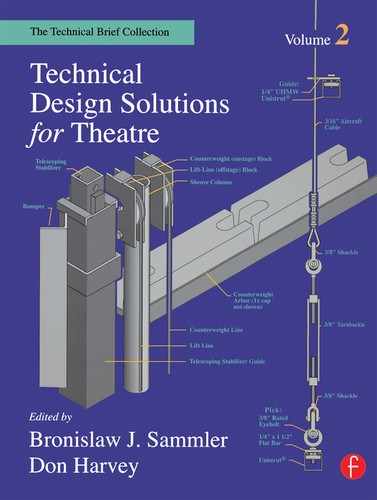Adriane M. Levy |
A Motorized, Mirrored Rain Effect |
For the Yale Repertory Theatre’s 1997 production of The Skin of Our Teeth, Director Liz Diamond and Lighting Designer Jennifer Tipton wanted to create a 5-minute stylized lighting effect to simulate the downpour during the flood. Since renting a scene machine was beyond the budget allocated for this effect, we looked for alternative solutions. Harking back to the days of disco, we experimented with the mirror-ball method of reflecting light. We worked with a lighting instrument and a drum covered in mirrored tiles — a rain drum. By changing the arrangement of the tiles, the angle of the light, and the rate of rotation, we were able to produce the effect we wanted. Though this article describes the drum built for our production, the details can be modified to fit your specific needs.
POSITION AND LIGHTING
For our effect, we placed 3 rain drums on the Yale Repertory Theatre’s first-beam catwalk, positioning them as shown in Figure 1. Each drum was lit by an Altman 6×16. The lens of the instrument was roughly 24″ away from the drum and we did not shutter or gel the instruments as we did not want to cut down on the light output. Since the reflected light had a taller spread than we wanted, we hung a sheet of tin on the catwalk pipe in front of the drum to act as a shutter.

FIGURE 1: MIRROR DRUM PLACEMENT
MATERIALS AND CONSTRUCTION
To build each drum, we used a 20″ length of 9″-diameter Sonotube® Each end of the tube was plugged with a ¾″ plywood disc. In the center of each disc, we drilled a hole for a 24″-long, ¾″-diameter steel drive rod. After drilling out one end of the drive rod to receive the shaft of a small motor, we tapped a hole for a set screw that would join the two. This design made the use of any belt or chain drive assemblies unnecessary. We welded a steel plate to the drive rod, as in Figure 2, and screwed it to the plywood plug to connect the drum and the drive rod.

FIGURE 2: MOTOR MOUNTING DETAILS

FIGURE 3: CONTROL CIRCUIT
Local craft stores sell small packages of ¼″ square mirror tiles, but we purchased ours in bulk from a Disco Supplies Dealer. We hot-glued each tile onto the drum in a random fashion, covering approximately 50% of the drum’s surface, making sure to leave spaces between the tiles and to orient them in different directions. The density and the randomness of the tiles’ placement affected “how hard it was raining” onstage: the more tiles we added, the harder it rained.
The frame was built out of 1×2 tube steel. The base measured 12″ × 22″; the uprights, 12″. We mounted a Dayton 12VDC gearmotor (model 2LO08) that we bought from Grainger onto the frame, centering its shaft in a 1″ hole that we had previously drilled in the center of one upright. To the other upright, we attached a UHMW block with a ¾″ hole in the center to act as a bearing. The drive rod fit snugly into the UHMW block on one end of the frame and was secured to the motor with a set screw on the other end.
CONTROL
Rather than buy a more expensive controller, we built the control circuit (see Figure 3) for the effect and ran control cables from the motors to the booth. The control box allowed us to plug into a 12OVAC outlet and vary the motor’s speed from a remote location. To achieve the look we wanted, we slowed the motors to 2 to 4 WM, causing them to become very noisy. Higher motor speeds cut down on the noise, but blurred the specks of light, ruining the effect. Our sound effects masked the motor noise, but you may want to choose a different motor if noise is an issue.
